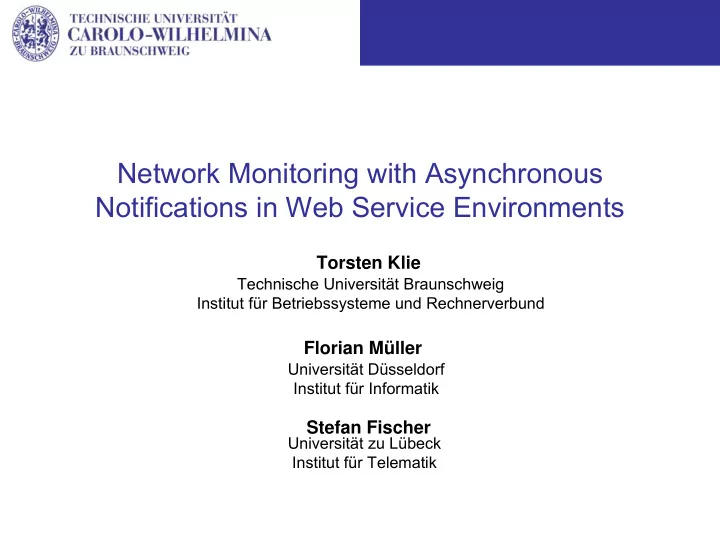

Network Monitoring with Asynchronous Notifications in Web Service Environments Torsten Klie Technische Universität Braunschweig Institut für Betriebssysteme und Rechnerverbund Florian Müller Universität Düsseldorf Institut für Informatik Stefan Fischer Universität zu Lübeck Institut für Telematik
Outline Introduction Comparison Our Approach Conclusions � Introduction � Motivation � Comparison of Existing Approaches � Traditional Approaches – SNMP Traps – Syslog � Approaches based on Web-Services – WS-Eventing – Oasis WSDM – Netconf � Our Approach � Design Overview � Implementation Details � Conclusions and Outlook Network Monitoring with Asynchronous Notifications in Web Service Environments 2/11 T.Klie, F. Müller and S.Fischer – SOA/SOC Workshop, KiVS 2007, Bern, Switzerland, 01.03.2007
Motivation Introduction Comparison Our Approach Conclusions � Growth of the Internet � Dependency on a reliable communications infrastructure is growing � Complexity of networks is growing � Monitoring large networks � Polling – Wasting resources if state does not change often – Hearbeat effect � Asynchronous notifications – Inform managers about important events � Failures � State changes – Management by exception � Our Requirements � Independent from management frameworks � Support for Web services Network Monitoring with Asynchronous Notifications in Web Service Environments 3/11 T.Klie, F. Müller and S.Fischer – SOA/SOC Workshop, KiVS 2007, Bern, Switzerland, 01.03.2007
Web Services for Network Management Introduction Comparison Our Approach Conclusions � Basis for future management infrastructures � Common Standards � SOA effectively used in e- business domain Divisions � Company aquisitions � Management processes are not � different than business processes � Web services composition Can be automated with Semantic � Web Technology Complementary technique to � policy refinement that can help to make management more autonomic Network Monitoring with Asynchronous Notifications in Web Service Environments 4/11 T.Klie, F. Müller and S.Fischer – SOA/SOC Workshop, KiVS 2007, Bern, Switzerland, 01.03.2007
Comparison of Existing Approaches Introduction Comparison Our Approach Conclusions Network Monitoring with Asynchronous Notifications in Web Service Environments 5/11 T.Klie, F. Müller and S.Fischer – SOA/SOC Workshop, KiVS 2007, Bern, Switzerland, 01.03.2007
Our Design Introduction Comparison Our Approach Conclusions � Manager-agent paradigm � Event tags: � Manager has GUID � fault � Agent integrated or proxy � information � Subscriptions � state change � Monitoring functions � configuration � periodic notification � Statistical functions � Event functions � Example: � Object: „processor load“ � Condition: „> 3.0“ � Parameters depend on use case and type of monitoring function Network Monitoring with Asynchronous Notifications in Web Service Environments 6/11 T.Klie, F. Müller and S.Fischer – SOA/SOC Workshop, KiVS 2007, Bern, Switzerland, 01.03.2007
Design Introduction Comparison Our Approach Conclusions � Configuration interface � subscribe (guid, mf, params) � unsubscribe (guid, handle) � reconfigure (guid, handle, params) � getMonitoringObjects() � getParameterInformation (mf) � getRegisteredMonitoringIn stances (guid) � Managers must provide call- back interface (pushNotification (guid, handle, msgClass, data) ) Network Monitoring with Asynchronous Notifications in Web Service Environments 7/11 T.Klie, F. Müller and S.Fischer – SOA/SOC Workshop, KiVS 2007, Bern, Switzerland, 01.03.2007
Implementation Introduction Comparison Our Approach Conclusions � Manager and agent � Monitoring function prototype in Java 5.0 implements monitor_run() � Monitoring functions � Generic monitoring thread in each agent � Implemented in � Calls monitor_run() agent.monitorObjects periodically � Arbitrary nesting levels (e.g. � Can be overridden, if needed agent.monitorObjects.s ystem.cpu.Temperature ) � One thread / manager (+ � Reflection corresponding notifications thread) � Manager Application � GUI � Control subscriptions � Display notifications Network Monitoring with Asynchronous Notifications in Web Service Environments 8/11 T.Klie, F. Müller and S.Fischer – SOA/SOC Workshop, KiVS 2007, Bern, Switzerland, 01.03.2007
Evaluation Introduction Comparison Our Approach Conclusions � Debugging & JUnit tests � Experiments with several scenarios 1 manager ↔ 1 agent 1. � Tests of configuration functions � Sending and receiving notifications n managers ↔ 1 agent: Checks for data isolation 2. 1 manager ↔ n agents: Generalization of (1) 3. n managers ↔ m agents: Most realistic tests 4. � Initial tests: good performance � More realistic tests (and comparisons with other approaches) Network Monitoring with Asynchronous Notifications in Web Service Environments 9/11 T.Klie, F. Müller and S.Fischer – SOA/SOC Workshop, KiVS 2007, Bern, Switzerland, 01.03.2007
Summary and Outlook Introduction Comparison Our Approach Conclusions � Summary � Compared traditional and new notification approaches � Discussed some details of our own notifications approach � Advantages – Management by delegation – Management by exception – Not bound to any management framework � Disadvantages – Larger footprint on agents – Larger foorprint due to managent by delegation – Not bound to any management framework � Future Work � Analyze interoperability problems � Investigate integrative solutions � Integrate prototype in our autonomic management architecture Network Monitoring with Asynchronous Notifications in Web Service Environments 10/11 T.Klie, F. Müller and S.Fischer – SOA/SOC Workshop, KiVS 2007, Bern, Switzerland, 01.03.2007
The End Introduction Comparison Our Approach Conclusions � Questions or comments? � Here and now: speak up! � Via e-mail to tklie@ibr.cs.tu-bs.de Network Monitoring with Asynchronous Notifications in Web Service Environments 11/11 T.Klie, F. Müller and S.Fischer – SOA/SOC Workshop, KiVS 2007, Bern, Switzerland, 01.03.2007
Recommend
More recommend